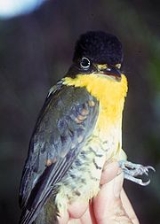
Shrike-like Cotinga
Encyclopedia
The Shrike-like Cotinga (Laniisoma elegans), also known as the Shrike-like Laniisoma or the Elegant Mourner, is a species of bird
in the family Tityridae
. As suggested by its common name
, it was formerly considered a cotinga
. As it is far from being "shrike
-like", this means that the widely used common name is entirely misleading. It is the only member of the genus
Laniisoma.
It is found in Atlantic forest in eastern Brazil
and disjunctly in humid Andean forests in Venezuela
, Colombia
, Ecuador
, Peru
and Bolivia
. It has been suggested that the Andean taxa (buckleyi, venezuelense and cadwaladeri) should be considered a separate species, the Andean Laniisoma (L. buckleyi). If this population was split off, the nominate taxon (elegans) would constitute a monotypic
Brazilian endemic, the Brazilian Laniisoma (L. elegans). It is generally rare and local throughout its range, and, if split, the Brazilian species would likely be considered threatened.
Bird
Birds are feathered, winged, bipedal, endothermic , egg-laying, vertebrate animals. Around 10,000 living species and 188 families makes them the most speciose class of tetrapod vertebrates. They inhabit ecosystems across the globe, from the Arctic to the Antarctic. Extant birds range in size from...
in the family Tityridae
Tityridae
Tityridae is family of suboscine passerine birds found in forest and woodland in the Neotropics. The approximately 30 species in this family were formerly spread over the families Tyrannidae, Pipridae and Cotingidae . As yet, no widely accepted common name exists for the family, although Tityras...
. As suggested by its common name
Common name
A common name of a taxon or organism is a name in general use within a community; it is often contrasted with the scientific name for the same organism...
, it was formerly considered a cotinga
Cotinga
The cotingas are a large family of passerine bird species found in Central America and tropical South America. Cotingas are birds of forests or forest edges, which mostly eat fruit or insects and fruit. Comparatively little is known about this diverse group, although all have broad bills with...
. As it is far from being "shrike
Shrike
Shrikes are passerine birds of the family Laniidae. The family is composed of thirty-one species in three genera. The family name, and that of the largest genus, Lanius, is derived from the Latin word for "butcher", and some shrikes were also known as "butcher birds" because of their feeding habits...
-like", this means that the widely used common name is entirely misleading. It is the only member of the genus
Genus
In biology, a genus is a low-level taxonomic rank used in the biological classification of living and fossil organisms, which is an example of definition by genus and differentia...
Laniisoma.
It is found in Atlantic forest in eastern Brazil
Brazil
Brazil , officially the Federative Republic of Brazil , is the largest country in South America. It is the world's fifth largest country, both by geographical area and by population with over 192 million people...
and disjunctly in humid Andean forests in Venezuela
Venezuela
Venezuela , officially called the Bolivarian Republic of Venezuela , is a tropical country on the northern coast of South America. It borders Colombia to the west, Guyana to the east, and Brazil to the south...
, Colombia
Colombia
Colombia, officially the Republic of Colombia , is a unitary constitutional republic comprising thirty-two departments. The country is located in northwestern South America, bordered to the east by Venezuela and Brazil; to the south by Ecuador and Peru; to the north by the Caribbean Sea; to the...
, Ecuador
Ecuador
Ecuador , officially the Republic of Ecuador is a representative democratic republic in South America, bordered by Colombia on the north, Peru on the east and south, and by the Pacific Ocean to the west. It is one of only two countries in South America, along with Chile, that do not have a border...
, Peru
Peru
Peru , officially the Republic of Peru , is a country in western South America. It is bordered on the north by Ecuador and Colombia, on the east by Brazil, on the southeast by Bolivia, on the south by Chile, and on the west by the Pacific Ocean....
and Bolivia
Bolivia
Bolivia officially known as Plurinational State of Bolivia , is a landlocked country in central South America. It is the poorest country in South America...
. It has been suggested that the Andean taxa (buckleyi, venezuelense and cadwaladeri) should be considered a separate species, the Andean Laniisoma (L. buckleyi). If this population was split off, the nominate taxon (elegans) would constitute a monotypic
Monotypic
In biology, a monotypic taxon is a taxonomic group with only one biological type. The term's usage differs slightly between botany and zoology. The term monotypic has a separate use in conservation biology, monotypic habitat, regarding species habitat conversion eliminating biodiversity and...
Brazilian endemic, the Brazilian Laniisoma (L. elegans). It is generally rare and local throughout its range, and, if split, the Brazilian species would likely be considered threatened.

